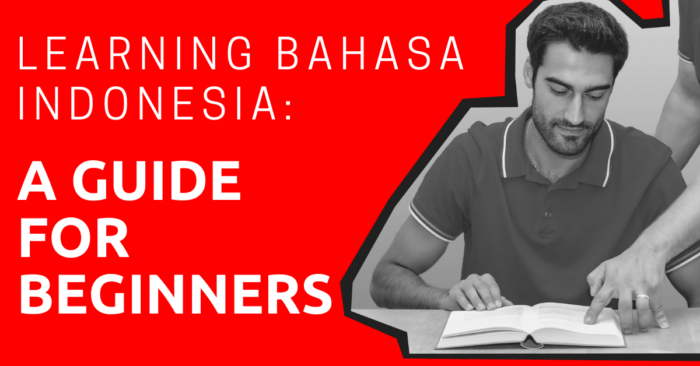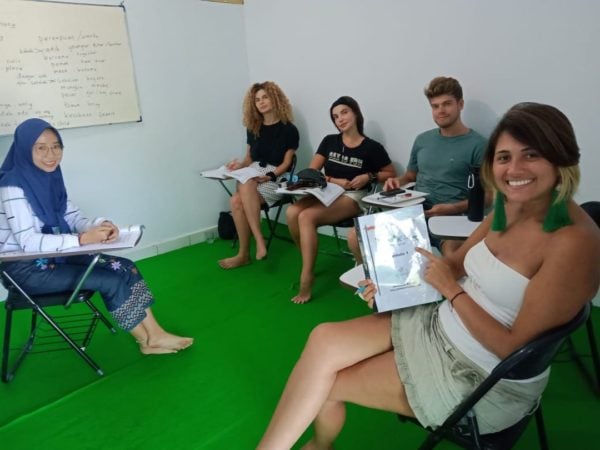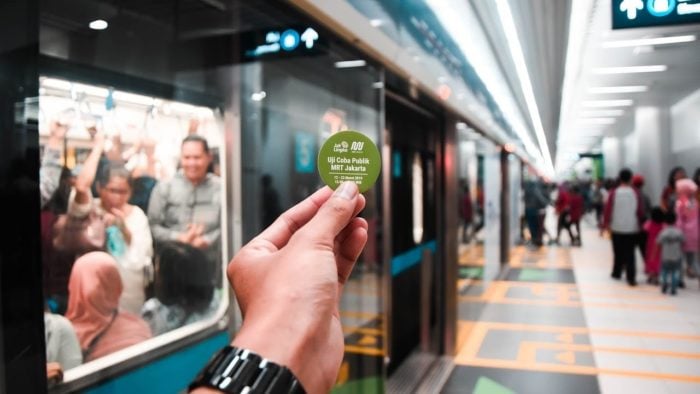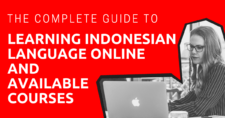
“Bahasa Indonesianya bagus banget waktu di telpon! Saya pikir ibu orang Indonesia! Waah! Bahasa Ibunya lancar!”
Roughly translated, the above sentence means: “You spoke Bahasa Indonesia so well on the phone! I thought I was speaking to an Indonesian! Wow! You speak good Bahasa Indonesia!”
My new insurance agent made that remark upon meeting me in person. I smiled and thanked him, basking in the compliment. The last ten years flashed before my eyes. I have come a long way in my journey in learning Bahasa Indonesia.
You too can learn how to speak the Indonesian language. In this guide, you’ll discover a few tips and tricks in learning Bahasa Indonesia that I’ve personally found effective.
If case you want to start learning Indonesian right away, check out Indonesianpod101. It’s the the most comprehensive online course I have found so far.
This article will take approximately 33 minutes to read. Don't have the time right now? No worries. Email the ad-free version of the article to yourself and read it later!
Disclaimer: This article may include links to products or services offered by ExpatDen's partners, which give us commissions when you click on them. Although this may influence how they appear in the text, we only recommend solutions that we would use in your situation. Read more in our Advertising Disclosure.
Contents
- About Me
- Is Bahasa Indonesia Easy to Learn?
- Bahasa Indonesia Language Basics
- Bahasa Indonesia Course
- Artificial Intelligence (Chat GPT)
- Best Way to Learn It
- Challenges in Learning Bahasa Indonesia
- Tips on Learning Bahasa Indonesia Fast for Beginners
- Is it Important to Learn Bahasa Indonesia?
- Origin of Bahasa Indonesia
- How to Start Learning Bahasa Indonesia Right Away?
- What to Read Next
About Me
From leaving Tanah Abang within five minutes of arriving in this famous wholesale market due to inability to communicate, to travelling and navigating different places alone, to acting as a translator for some of my expat friends in Indonesia, I have come a long way. In fact, after moving to Indonesia, I have conversed in Bahasa Indonesia constantly — not just in offices but also in factories, mines, and other places where people speak a range of different languages.
While the journey has been rewarding, it definitely wasn’t as ‘lancar’ (lan-char) or ‘smooth’ as the health insurance agent thought it had been. There were a few bumps in the road in my attempt to assimilate Bahasa Indonesia in my daily conversations.
They make for funny anecdotes now, but there have been particularly sticky situations. One involved an encounter with a taxi driver who mistakenly took me to an unknown park (‘taman’) after I casually mentioned to him during our conversation that I was visiting a friend (‘teman’).
There were a few other troublesome scenarios involving certain text messages that I received; someone sent me messages with the words ‘hati2’ and ‘sama2’, which I later discovered meant ‘hati-hati’ (take care) and ‘sama-sama’ (same to you), respectively.
Yet another situation involved noun numbers. I discovered that in Bahasa Indonesia, plural nouns are indicated by using the same word twice (e.g., ‘anak’ means child and ‘anak-anak’ or ‘anak2’ as spelled in most SMS means ‘children’).
Then there was an incident where I kept looking for a place called ‘Jaksel’ only to realize that it meant Jakarta Selatan, the local name of South Jakarta. I later learned other commonly used abbreviations or ‘singkatan’ that are absolutely integral to the usage of colloquial Bahasa Indonesia or ‘Bahasa Gaul’ (slang language).
Is Bahasa Indonesia Easy to Learn?
Because Bahasa Indonesia was influenced by several languages from Asia and Europe, particularly given its Latin script and more importantly, its flexible grammar structure, little wonder it is one of the easiest languages to learn.
Normally, the level of difficulty depends on the background of the speaker/learner. For example, An English speaker may find it easier to learn French compared to, say, Thai, because both English and French belong to the same language group and may have a lot in common.
Personally, while I haven’t learned French, I have learned German and Spanish, which belong to the same ‘Indo-European’ class. German and English, in particular, belong to the same language sub-group even. Despite this, I have found Bahasa Indonesia definitely easier to learn than German or Spanish.
With Bahasa Indonesia’s flexible grammar structure, I was able to communicate effectively within 5-6 weeks of studying it. Studying German and Spanish took much longer due to grammar as well as pronunciation rules.
That said, knowing how to speak German helped me master the pronunciation of Indonesian alphabet because their pronunciation is similar to the pronunciation of Dutch letters; there is a close association between German and Dutch languages.
Bahasa Indonesia Language Basics
Within the last century, after the adaption of Bahasa Indonesia as the official language and in the present, the language has not just survived but has thrived and has been enriched by mixing with local languages, to develop distinctive features.
Let’s look at some of the language’s features.
Alphabet
Similar to English, Bahasa Indonesia uses Latin script, which was introduced by the Dutch during the colonial period.
For a beginner, this is the most convenient aspect of learning Bahasa Indonesia as you don’t have to make sense of characters of the script. The familiar letters of the alphabet shall also make it easier for you to learn.
Letters of Alphabet Pronunciations
Due to Dutch influence, pronunciations of the letters of the alphabet are closer to Dutch pronunciation.
For example, the ‘v’ sound in Dutch is pronounced closer to the ‘f’ sound in English. Bahasa Indonesia adopts the Dutch pronunciation. So while pronunciations could be off the mark for someone who may not be aware of this, help will always be available.
Words can be written down so the reader can interpret easily.
Phonologically Consistent
Thirdly, and this is a relief to even speakers of English — Bahasa Indonesia is phonologically consistent. That is, how you spell is exactly how you pronounce it.
This makes it substantially easier to learn than some other languages that use Latin script, such as French or Vietnamese (which was a French colony at one point and was influenced by the French). In this regard, it is even more consistent than English, which is considered highly irregular in terms of phonological consistency.
This also makes it easier to learn as compared to several ‘Eastern’ languages such as Chinese, Vietnamese, Thai, or Japanese, which all have tonal inflections and in which the meaning entirely varies for every word, based on its inflection/pitch or a slight difference in pronunciation.
Flexible Grammar
While knowing grammar is inherent to learning any language, there is so much flexibility in Bahasa Indonesia compared to languages such as English, that sometimes it is possible to communicate without following exact grammatical rules and syntax. Let’s consider some important aspects of grammar.
Subject-Verb-Object Not Necessary
While sentence structure in Bahasa Indonesia usually follows the order of ‘Subject-Verb-Object’, the meaning can be adequately conveyed without sticking to this order.
For example, in the case of English, French, German, etc., the usual order of words in a sentence follows the rule of ‘subject-verb-object/adverb/complement’. In many cases, the colloquial Bahasa Indonesia doesn’t necessarily follow this rule and is still acceptable. In the following sentence:
‘The handyman came today.’
can be written as:
‘Tukang datang hari ini.’ (Handyman came today) or
‘Hari ini datang tukang.’ (Today came the handyman) or
‘Datang tukang hari ini.’ (Came the handyman, today — unusual use but still acceptable)
All three usages will be perfectly acceptable in colloquial speech.
No Case Inflections
Bahasa Indonesia is free from case inflections. Instead, the position of a noun is clear based on its context and placement in a sentence. For example:
| ‘Mereka’ = They | English | Bahasa Indonesia |
| Nominative case | They come | Mereka datang |
| Accusative | I ask them | Saya tanya mereka |
| Possessive | Their bag | Koper mereka |
Notice how the word ‘mereka’ has remained constant, including its possessive form where ownership of an object is indicated by placing it before the owner. That is, ‘koper’ is placed before ‘mereka’. Similarly, ‘my book’ will be expressed as ‘buku saya’ where saya means ‘I/me/my/mine’, depending on the context. Buku means ‘book’.
No Tenses/Verb Conjugations
In Bahasa Indonesia, the tense is suggested by certain words. For example:
| ‘Makan’ = to Eat | English | Bahasa Indonesia |
| Present tense | He eats an apple | Dia memakan apel |
| Present continuous | He is eating an apple | Dia sedang memakan apel |
| Past tense | He ate an apple | Dia sudah memakan apel |
| Future tense | He will eat an apple | Dia akan memakan apel |
Notice how ‘memakan’, which is the active form of root verb ‘makan’, remains constant and tense is indicated by specific words placed before the verb (sedang, sudah, akan). Other forms of tenses are usually worked out contextually.
No Grammatical Gender
In Bahasa Indonesia, ‘dia’ is the common word used to indicate he/she or ‘it’, and gender is worked out contextually. For example, ‘Dia sibuk’ can mean ‘He is busy’ or ‘She is busy’. Speakers can easily determine the gender based on the context of the conversation.
No Plural Forms
There are no plural forms to keep in mind. The plural is indicated by simply repeating the word. For example, a flower means ‘bunga’ in Indonesian and ‘flowers’ is indicated by saying ‘bunga-bunga’. In SMS language, this is being written as ‘bunga2’. This is important to remember!
Adjectives
Usually, adjectives are placed after the noun, unlike in English. For example, ‘a small child’ is expressed as ‘anak kecil’ (a-nak ke-chil) where ‘anak’ means ‘child’ and ‘kecil’ means ‘small’). In another example, ‘blue shirt’ is expressed as ‘baju/kemeja biru’ where ‘biru’ means ‘blue’ and ‘baju/kemeja’ means ‘shirt’.
You can read our learn Indonesian resource to find out more.
Bahasa Indonesia Course
Now that I’ve explained how the language is quite simple and free from complicated grammar rules, let’s discuss various ways to learn it.
Fortunately, there is a plethora of sources and information available at our fingertips. As discussed in the earlier section, it is important to practice the language, which you can do by interacting more and more with the locals. Here are other ways you can explore to learn Bahasa Indonesia.
Online
The easiest way today to learn the language through online learning sites. With online resources, you can begin to learn it even before you’ve landed in Indonesia.
Online course structures, downloadable episodes, and various study materials provide an opportunity to learn on the go and allows flexible studying hours.
Thriving online communities in various sites lead to engagement and feedback. These, however, need to be supplemented by consistent practice. Some of the popular online resources for learning Bahasa Indonesia are:
Indonesianpod101.com
Indonesianpod101.com is by far the most comprehensive online course that I have come across. It offers:
- Audio and video lessons available on the go
- Mobile apps
- Vocabulary tools such as flashcards, word lists, and word-of-the-day daily email that gives you a byte-sized lesson in Indonesian. I signed up for this service and loved learning a new word every day.
The website offers comprehensive tutorials in Bahasa Indonesia that can be accessed based on the level of difficulty. At the time of sign-up, you may select from ‘absolute beginner’, ‘beginner’, ‘intermediate’, and ‘advanced’ levels.
For each level, you get a set of study materials comprising audio, video, and reading comprehension lessons that cover everyday situations. You can begin at the level you are comfortable with and you can learn whenever you have time to spare. The site keeps track of your progress. Premium members receive regular assessments.
Indonesianpod101.com offers three plans:
- Basic, for US$4 per month
- Premium, for US$10 per month
- Premium Plus, which offers various lessons, for US$23 per month
As of now, when you sign up for the first time you can also get a month-long preview of the course material for just US$1. This lets you access all the content on the site.
In fact, you get access to a bunch of material, including:
- in–depth lesson notes
- more than 100 vocabulary lists
- updated content every week
- read–along lesson transcripts
- multiple–choice assessments
- line–by–line audio dialogues
- personalized word banks
- spaced repetition flashcards
- access to the Indonesianpod101 app for one month
This gives you a taste of what you get and will help you decide whether to continue with the subscription.
All the lessons on Indonesianpod101.com offer a variety of time durations ranging from two minutes to 17-18 minutes, which you can play as per the time at hand. The premium membership gives you access to 150+ hours of learning materials taught by real teachers, top 2,000 words list, flashcards, word bank, audio dictionary, daily mini-lessons, more apps, tools, and quizzes.
Indonesian Online
Indonesian Online offers a variety of courses that you can use no matter what language level you’re at. Originally based on the book, The Indonesian Way, by Dr. George Quinn, the course was founded by Dr. Urlich Kozok, a professor of Bahasa Indonesia at the University of Hawaii.
The site offers a mix of online, interactive, and offline content for various levels of Bahasa Indonesia language learners. It starts at the novice (A1) level and goes up to advanced (C2) level.
To begin with, it offers a one-month preview of courses for The Indonesian Way at just US$10. You get 113 online lessons with interactive exercises. You can later extend this into a student or premium membership.
You can find all the resources and course prices offered by Indonesian Online on on this page. Three main categories are:
- Beginner (The Indonesian Way), US$90 for a two-year membership of content of around 220 hours
Advanced, a three-year membership of around 330 hours of content and a combination of beginner and advanced levels for US$195 for a total of five years
Free Websites
While these websites offer free study materials, they don’t provide audio or video tools. The guidance of an Indonesian native speaker may be required if you are entirely new to the language. These include:
- Live Lingua’s Indonesian page
- Indonesian course on Archieve.org which consists of two parts: part 2 and part 3.
- Websites like ilanguages, Ielanguages, 50languages, Hello Indonesia offer a compilation of beginner word lists and basic grammar.
- Bahasakita is a guide on language, culture, and overall serves as an online resource for learners as well as teachers.
Online Tutors
Online tutors offer the convenience of learning within the comfort of your own home as and when you need, and at the same time, give you the privilege of real-time feedback by an expert. It is equivalent to private tuition via online platforms such as Skype.
Jembatan Bahasa, a language school in Bali, has really good online tutors. Being a language school, they have a systematic way to teach students. Their teachers are certified and have experience teaching international students.
They even offer textbooks, learning apps, and audio lessons which can’t be found on other online tutor websites. A private online class at Jembatan Bahasa starts at Rp2,700,000 (~US$180) for a 30-hour course, which is quite cheap compared to other websites.
Websites like italki let you choose tutors with varied profiles, pricing, and experience levels.
Chinta Bahasa offers online private coaching. They offer one-on-one or group tuition for a variety of durations. Depending on the course objective, number of students, and duration, their rates start at US$155 per hour.
Cakap offers various classes, including corporate classes, at Rp 115,000 (US$7.5) per session.
In addition to this, there are many websites available for finding an online tutor including Preply, Tutoroo, Superprof, and teacheron
Classroom and Private Tutoring
Most of the urban centers and tourist destinations in Indonesia offer classroom coaching opportunities. Those outside of Jakarta, Yogyakarta, Bandung, and Bali are particularly known to attract international students of Bahasa Indonesia.
In case you are in Bali, you should check out Jembatan Bahasa. They have good course structure and different strategies to help you engage in learning the language.
Not only do you learn the language here, but also culture from their certified Indonesian teachers, which is another nice way to get to know locals. Their courses are also affordable.

Language Training Centers and Universities
Various universities offer certification courses, too. For example, in Jakarta province, Universitas Indonesia, Universitas Negeri Jakarta, Universitas Atma Jaya, and Universitas TriSakti have language departments that offer courses designed for beginners/non-native speakers of Bahasa Indonesia.
Outside Jakarta, mostly government universities offer such courses. The famous Universitas Gadjah Mada in Yogyakarta has also established the Indonesian Language and Culture Learning Service (ILCLS), which is quite popular among foreigner students and offers a variety of courses to learn Bahasa Indonesia.
In addition, a vast majority of long term expats who are seriously interested in learning Indonesian also go to Yogyakarta and study intensively at either Alam Bahasa or Wisma Bahasa language school.
The private learning centers are aplenty. Some examples include AIM for English, which also offers Bahasa Course for individuals and groups, the Indonesia Australia Language Foundation, the Jakarta Communication Club, and many others.
I have mentioned these from Jakarta, however, for other major urban centers, similar language training centers are available.
Indonesian Language Books
For those who prefer the more traditional form of learning through books, a lot of options are available. Many Indonesian language books come with audio support on their respective websites or CD-ROMs to learn the pronunciation.
Some examples are Speak Standard Indonesian, Indonesian for beginners, Easy Indonesian, and Learn Indonesian: Start Speaking Today.
Mobile (iOS and Android) Apps
Any modern compendium will be incomplete without the inclusion of mobile apps, which are, fortunately, available for learning Bahasa Indonesia, too.
Some examples include Duolingo, Rasa Bahasa, Learn Indonesian Free, Learn Bahasa Indonesian, and so on.
YouTube Channels
YouTube has become an indispensable source of modern educational resources. Indeed, there are very interesting YouTube channels that can teach Bahasa Indonesia. One of the main benefits of seeing the teacher is to engage the student/audience.
Some popular channels include Indonesianpod101.com’s YouTube channel, a series by Ira Carolina which is quite comprehensive, a series of videos by Indonesian 101 and this series.
Learning with Friends
With such an abundance of resources, you might wonder if there is any need to go out and practice the language to facilitate learning. I would say that despite these resources, nothing can replace good old banter!
The practical use/application of knowledge leads to its assimilation, and this is more so in the case of learning any new language. The more you actually use it, the more you learn as you go along. For this, your Indonesian friends will be of tremendous help.
In general, the Indonesians are appreciative of any attempts made to learn the language and will help you along, regardless of whether they are a shopkeeper, a cab driver, or a pedestrian.
Recently, more people are using Instagram to learn a language. The platform offers bite-sized lessons presented in a fun way. I follow some of the most interesting language teachers on Instagram.
For Bahasa Indonesia, I recommend Indonesian with Lauren and Learnbahasa.Indonesia – but there are many more.
Most of these social media teachers offer courses or one-on-one coaching.
Artificial Intelligence (Chat GPT)
Chat GPT has revolutionized many aspects of life since its introduction in November 2022, and language learning is no different. Here’s how it can help you learn Bahasa Indonesia.
- Vocabulary and phrases: Chat GPT can share word lists and translate specific words and phrases from English to Bahasa Indonesia. For example, to test Chat GPT for this feature, I asked it to provide a word list for tourists and a second word list for a commodity trader attending a business conference. It made me both these word lists with ease.
- Grammar and sentence structure: Chat GPT can correct your grammar and sentence structure. I ran a test using simple sentences, and Chat GPT was able to offer me correct suggestions. But it’s important to note that suggestions are usually formal.
- Pronunciation: You can ask Chat GPT to provide phonetic transcription (pronunciation) of words.
- Conversation practice: This feature of Chat GPT is fun. I have been using it on and off to enjoy a quick friendly chat at times. For example, just a while ago, after I defined its role as native Bahasa Indonesia speaker, I asked Chat GPT to hold a conversation with me about the weather in Bahasa Indonesia. It chatted with me in Bahasa Indonesia till my heart was content.
- Translations: Chat GPT can translate and refine your Bahasa Indonesia text. However, I prefer not to use this feature because its language is fairly formal, whereas I prefer to use colloquial, pedestrian expressions. However, as a newcomer, you might find it an upgrade to Google Translate, which is very popular among newly arrived expats.
- Cultural insights: Chat GPT can be used to learn cultural insights and information on traditions and other nuances instead of using Google. Chat GPT will spool information from resources and provide you one concise answer. You can use this for a broad overview.
My personal brief experience with Chat GPT tells me that, so far, the language used by Chat GPT is quite formal. In day-to-day life, the spoken Bahasa Indonesia is less formal even in official situations. So, while Chat GPT might be used as a support tool from time to time, it can’t be considered your go-to resource, at least not for now.
Best Way to Learn It
My approach to learning Bahasa Indonesia was a mix of a lot of these sources. I accessed Indonesianpod10, in addition to my extensive use of various online dictionaries (kamus).

However, what hastened my learning were daily conversations with my ‘pembantu’ (the help), the security staff in my Apartment complex, cab drivers who took me everywhere in Jakarta, and sales assistants in various stores/shops.
Once I made a lot of friends, I made a point to reserve a part of the time spent with them in speaking Indonesian as well as clarifying my doubts. When I started working, I received a private tuition, as well.
I kept polishing my Bahasa Indonesia skills by listening to Indonesian songs, watching TV Indonesian programs with English subtitles (for example, news channel Berita Satu runs news bulletins with English subtitles), listening to radio stations and even trying to read Indonesian newspapers and news websites.
In other words, I would not; have been able to retain what I’ve learned if I hadn’t made it a point to speak Bahasa Indonesia in my day-to-day routine.
Challenges in Learning Bahasa Indonesia
What is most challenging about learning the Indonesian language?
In my experience, it was the easiest language to learn. So the challenges I encountered while learning it were still lesser than, say, the challenges I’ve had while learning German, with its complicated grammar rules.
However, I will state the following challenges that I’ve encountered and also some tips about how to surmount them.
The Affixes
This is arguably one of the very few complicated aspects of Bahasa Indonesia and can come across as daunting initially. Various affixes are attached to a root verb to convey different meanings.
There are about 40 affixes to keep in mind. Fortunately, they follow a definite usage pattern that makes learning Bahasa Indonesia relatively easy.
Let us consider an example: Root verb = Bantu which means ‘to help’
| Affix | Word | Meaning | Sentence | Meaning |
| Me-m- | Membanu | The active form of helping | Dia membantu anak. | He helps the children. |
| Pe-m- | Pembantu | The help/maid | Pembantu telah mencuci piring. | The maid has washed the plate. |
| Ter- | Terbantu | Passive form | Dia sudah terbantu oleh polisi. | She was helped by the police. |
| -An | Bantu-an | Assistance | Tolong hubungi pusat bantuan. | Please contact the help center. |
While the above may confuse beginners, affixes do follow consistent rules. Hence, with regular practice, it is possible to master them.
While this is the most challenging part of learning Bahasa Indonesia, with experience you shall be able to decipher the underlying system in their usage.
For example, the use of ‘Mem’ as an affix is typically for root verbs that begin with consonants P or B. ‘Bikin’ is a root verb, which means ‘to make’. ‘Membikin’ is the active form of ‘make’ or ‘build’. ‘Pem’ is used to form a noun; ‘Pembikin’ then means ‘maker’.
The beauty of this system is that you need to familiarize yourself with the root verb. And by considering the context, you can make out the meaning in many instances.
Bahasa Gaul
Bahasa Gaul, or ‘slang language’, refers to the different varieties of Indonesian spoken across Indonesia. The slang usually has been influenced by the native language.
In the case of Jakarta province, the language was influenced by Betawi, Javanese, and Sundanese languages. For example, to say ‘I am eating an apple’, standard Bahasa Indonesia will use ‘Saya sedang memakan apel’ whereas in Bahasa Gaul, it is ‘Saya lagi makan apel’. Notice how I have dropped the affix and replaced ‘sedang’ with ‘lagi’.
A simple word such as ‘saya’ or ‘I’ (in English) can be expressed as ‘aku’, ‘gue’, or ‘gua’, for example, and has varying degrees of formality. ‘Saya’ is the most formal form while ‘gua’ is used in extremely casual situations.
Bahasa Gaul words are sometimes so different that it is difficult to make out the meaning if you have studied only formal Bahasa Indonesia. If you plan to live in Indonesia for a longer duration, it is very important to know and practice Bahasa Gaul in order to follow, participate in, and enjoy the conversations.
Well, the Bahasa that you will learn from most sources is the ‘Standard Bahasa Indonesia’ version, used formally. If you intend to use Bahasa for official purposes or to travel, this is sufficient.
But if you’d like a taste of the culture, you intend to stay longer periods, and make Indonesian friends, chances are that you might not understand some conversations at all if you are not exposed to Bahasa Gaul or the colloquial version.
To add to the woes, Bahasa Gaul changes with dialects, from place to place. I have mostly lived in Jakarta only and hence am used to the Jakarta version of Bahasa Gaul.
Abbreviations or Singkatan
Indonesians like to shorten words quite often “for efficiency”, and this has created a whole new lingo. If you plan to stay in Indonesia long-term, this is essential to remember. Younger generations use them, so it’s easy to understand this parlance if you need to speak Bahasa Indonesia regularly.
Officially, there aren’t any specific glossary of such words, ‘singkatan’ as they are known. They are created on the fly and understood contextually.
It starts with names; names are shortened in a manner unique to Indonesia, based on my experience.
For example, I know an Audrey who goes by ‘Drey’, a Josephine who is called ‘Pin’, a Trisnawati who is called ‘Wati’, a Dina who goes by ‘Din’, and Rohima who gets called ‘Him’ (pronounced as ‘im’).
Male names are shortened too, and I was tricked especially with male names where an Arianto became ‘Ari’ while a Yusuf was being called ‘Suf’. Though eventually, I realized that the more I immersed myself into conversations with the locals, my abilities to work out an abbreviation improved manifold.
Such abbreviations exist in all walks of life. In fact, it can be used colloquially for any given word. Say a parking attendant says ‘up’ (oop) instead of ‘cukup’ (chukoop) to say ‘enough’ while guiding you to a parking lot or to ask you to move a little more. ‘Sedikit’ is the word for the English word ‘little’. The attendant may use ‘dikit’.
Other examples include locations. Typical mall names, for example, ‘Ambas’ is the shortened name of ‘Mal Ambassador’, ‘Sensi’ is ‘Mal Senayan City’, and so on. These are so prevalent that they are used formally, too.
Furthermore, to indicate directions in Jakarta, terms like ‘Jaktim’, ‘Jakpus’, ‘Jaksel’, etc., are shortened versions of Jakarta Timur (East Jakarta), Jakarta Pusat (Central Jakarta), Jakarta Selatan (South Jakarta), respectively.

The national monument is called ‘Monas’, which is the short form of Monumen Nasional. Certain national communities for so and so are called ‘Komnas __ __’. Even the ministries have had the same fate. ‘Kemenkes’, for example, refers to Kementerian Kesehetan (the health ministry). The ministry of information and broadcasting is called ‘Kemkominfo’ and formally so. ‘Bapak’ is the original word for formal titles/honorifics: Mister is usually shortened to ‘Pak’, while the female ‘Ibu’ is shortened to ‘Bu’.
All in all, the ‘singkatan’ can create some confusing situations initially, but you will soon learn how they work. You may even come up with your own.
Sometimes you wouldn’t know whether a word is real or an abbreviation. The only solution to this is to get more exposed to the local language. In general, Indonesians are very friendly and they appreciate foreigners attempts to communicate in Bahasa Indonesia.
With the language’s flexibility, a beginner will be fairly capable to communicate. There’s bound to be some confusion, but things get easier pretty soon.
In fact, Indonesians are quite encouraging of foreigners trying to learn Bahasa Indonesia that they will offer a lot of help at every step including making sense of your random sentences that might not be grammatically correct.
In my own journey, I have used root verbs many times initially without adding any prefixes and have been able to communicate well. The credit goes to the friendliness and encouragement of the locals.
Tips on Learning Bahasa Indonesia Fast for Beginners
Below are my personal tips and tricks to learning the language.
Love What You Do
When you love what you do, chances are you will excel in it. This applies to learning Bahasa Indonesia. Let your interest in Bahasa Indonesia be all-consuming. Get immersed in all things Indonesia — its vibrant culture, the friendly locals, its interesting cuisine, delightful greenery, and so on. This will enrich your attempts to learn and speak Indonesian.
No Pain, No Gain
Practice regularly. Consistency is the key to mastery. Commit yourself to the goal of understanding Indonesia and its culture, and communicating in Bahasa Indonesia will come to you naturally.
Small Steps, Every Day
Begin with small steps. Let early success propel your interest and keep you motivated to learn Bahasa Indonesia. Learn everyday phrases and conversations earlier rather than its rules, to retain interest.
Is it Important to Learn Bahasa Indonesia?
You might want to learn Bahasa Indonesia for various reasons:
You might want to learn it as a tourist — to experience the beauty of Indonesia, be able to travel hassle-free and bargain your way through the tourist destinations. Or you might want to learn it to enrich your traveling experience by connecting with locals and getting closer to their culture and lifestyle.
You might be a student or an expert who needs to stay in Indonesia to study the local language and culture. Some might just be lovers of languages and want to learn a language and its intricacies.
If you have moved to Indonesia with long-term plans to stay, however, be it on account of leisure or studies or work, you will need to learn Bahasa Indonesia. While most of the youth at the universities today can speak English, you will need to interact with the locals from every walk of life.
Learning Bahasa Indonesia is going to help your life in Indonesia much more convenient including when you need to visit a dentist in Indonesia.

Bahasa Indonesia is the lingua franca in Indonesia and the primary language for all communication.
Even in urban areas, you will need to use it as a majority of people do not speak English. You need to be aware of basic Bahasa Indonesia at minimum to navigate your way across Indonesia, to conduct day-to-day activities like shopping, traveling, or even visiting dental clinics.
Indonesia is also a very big country. Once you are out of Bali and Jakarta, which are only a small part of the country, you need to speak some Indonesian to survive.
Furthermore, if you are working in Indonesia, this regulation makes it mandatory for you to be aware of Bahasa Indonesia. There have been talks of implementing the language rule strictly, though it has not been enforced yet. However, given that government regulation is already in place, you’d be well-served to learn Bahasa Indonesia.
Origin of Bahasa Indonesia
Bahasa Indonesia evolved from Bahasa Melayu, the language used in the Malay Peninsula. It is the mother of the languages spoken in Singapore, Malaysia, Brunei, Indonesia, East Timor, and some parts of Thailand.
In addition, Bahasa Melayu, an Austronesian language, was heavily influenced by Sanskrit, Tamil, and Arabic. This is corollary to Indonesia being a cultural melting pot, with the arrival of the Indians, Arabs, Chinese and Portuguese at various periods in history.
Meanwhile, the Dutch came in the early 1600s and traders gradually colonized Indonesia and left in 1942. The country’s colonization left a lasting impact on its culture, and particularly its language.
This is why there are several loanwords in the Indonesian language. That is, there are a lot of words in Bahasa Indonesia that are similar to several Austronesian languages like Tagalog (Filipino language), Fijian, and even the Maori language.
As a regular traveler within the Malay Peninsula, I love comparing the similar-sounding speeches. As my Bahasa Indonesia gradually improves, so does my understanding of other similar languages.
Note that I use the term ‘Bahasa Indonesia’ instead of ‘Indonesian’. While these two terms are used interchangeably nowadays, in reality, there is no specific ‘Indonesian language’.
Indonesia has multiple languages in every region, such as Basa Java in Java or Basa Bali in Bali, and so on. As of now, more than 700 languages, including Basa Java (Javanese language), Sundanese, Minangkabau, and so on.

Bahasa Melayu was made the official language of administration by the Dutch traders who had established their trading post in ‘Batavia’ or present-day Jakarta. Bahasa Melayu was also the language used by the elite in trading.
The Dutch continued to use it and as they colonized the entirety of Indonesia, Bahasa Melayu came to be used more and more commonly. Its liberal mixture with the local languages as well as a variety of loanwords from Dutch is what has resulted in the modern-day Bahasa Indonesia.
Bahasa Indonesia is, in fact, the lingua franca of the archipelago. It was adopted as the official language by the freedom fighters during the freedom movement in 1920.
After its independence, Indonesia continued to use and propagate Bahasa Indonesia as lingua franca for administrative, education, media, and other official purposes. As a result, all the Indonesians can speak Bahasa Indonesia though their native language may be different.
Presently, there are about 43 million native speakers of Bahasa Indonesia, while 155 million speak it as their second language. However, the number of native speakers has gradually increased as more people moved and shipped their belongings to urban areas in search of employment, intermarriages between various communities, and other such practical reasons.
The younger generation, however, may not be familiar with their original native language. Urban Indonesians, specifically, do not learn their real native languages in many instances and yet still be called ‘native speakers’ of Bahasa Indonesia.
How to Start Learning Bahasa Indonesia Right Away?
In my opinion, the best way to start learning Bahasa Indonesia right away is to sign up for IndonesianPod101. It’s one of the best online courses I’ve come across so far.
Plus, by paying for the course, you’ll feel more motivated to learn since you’ve already made the investment.
Lastly, and I cannot stress this enough, it’s important to practice speaking it with the locals. Mingle, mingle, mingle. You will learn Bahasa Gaul more by mingling. You will receive instant feedback from your friends.
I wish you all the success in your plans to learn Bahasa Indonesia. Don’t forget to enjoy your journey!
What to Read Next
- Bahasa Indonesia Adjectives: Types, Forms, and How to Use
- Bahasa Indonesia Adverbs: Types, Forms, and How to Use
- Bahasa Indonesia Noun Affixation: Understanding How Nouns Change in Indonesian
- Bahasa Indonesia Nouns: Gender, Number, Case, Possession, and Modification
- Bahasa Indonesia: Parts of Speech
- Bahasa Indonesia Pronouns: Personal, Possessive, Demonstrative, Interrogative, and Indefinite







